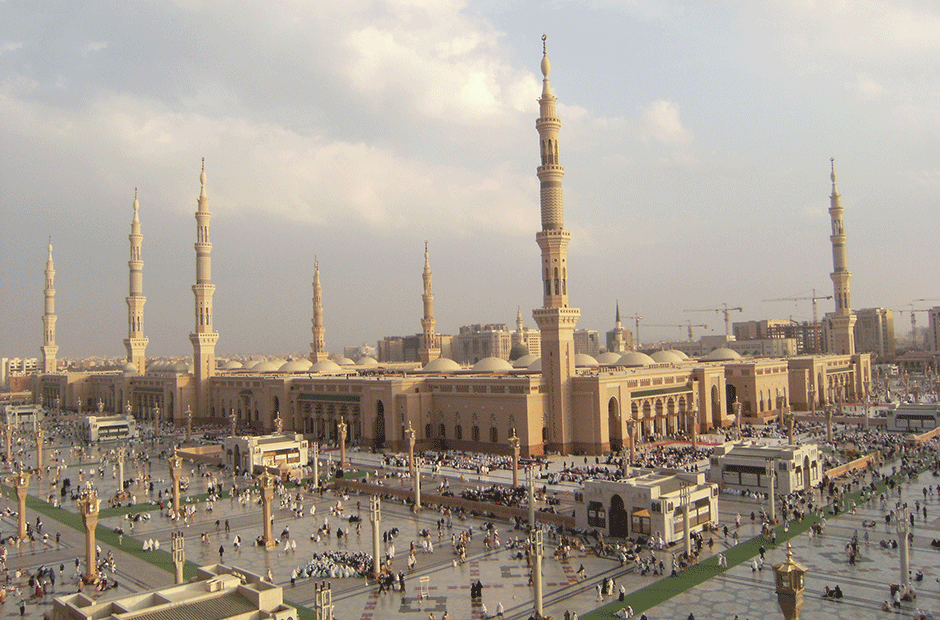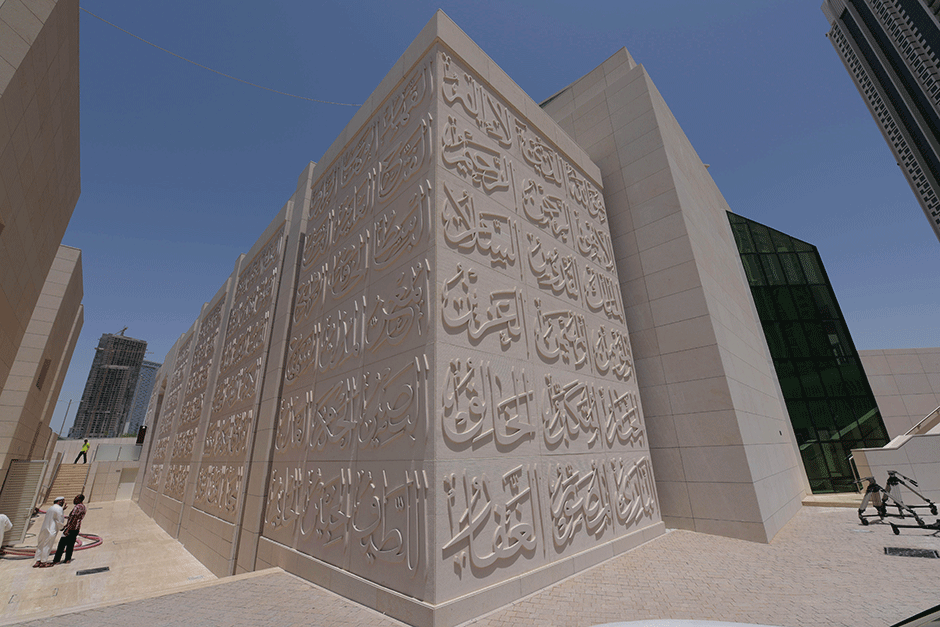
A place to come together for prayer, masjids, or mosques, started off as simple open spaces pointing towards the direction of Makkah, Saudi Arabia and over time developed into the most quintessentiallyIslamic building. Built to last, mosques offered the finest examples of Islamic architecture, developed into the nerve centre of the growing Muslim communities - with the absence of public buildings like town halls and law courts, mosques (in addition to places of worship) became the place where such affairs were also conducted – combining the spiritual with the secular. As Islam spread outside the Arab Peninsula, mosques became more elaborate by absorbing the vernacular architectural influence of new Islamic territories. And ultimately, recognising the ability of architecture to immortalise wealth and power, mosques became more luxurious, richly decorated and witnessed the introduction of domes, arched entrances and subsequently minarets in the 8th century.
Mosques in the 21st century still function as the centre of Muslim communities with a much more limited role: a place of workshop and the centre of Islamic teaching. With this diminishing secular significance, mosque buildings today are designed and built with the same premise as the original Masjid Al Nabwi (the Mosque of the Prophet), considered the first mosque in Islamic history by most.
With the home of the Prophet Mohammad (PBUH) in Madina, Saudi Arabia at its root, the 1,000-sq-metre Masjid Al Nabwi constructed in 622 AD gave rise to key fundamental features that can be found in any and all mosques across the world constructed to date. These include the mihrab (niche at the front of the prayer space) and the minbar (tiered pulpit; originally a chair where prophet stood elevated to be seen by the congregation when delivering sermons), the sahan(courtyard) enclosed/ bordered by a riwaq(arcade) and a musallah(covered prayer hall).
Known as the hypostyle mosque, Masjid Al Nabwi influenced mosque building for centuries to come. It has beenexpanded significantly and witnessed various additions including the famous dome and the four minarets under the rule of various empires including the Umayyad, Abbasid and Ottoman the house of Saud. Covering a staggering 157,935 square metres, the mosque today measures larger than the original city of Medina and is considered to be the second-largest mosque in the world.
Mosques in the UAE
The UAE is home to many mosques that belong to the early Islamic period. Most of these historical structures are derivative of the hypostyle mosque with a few rare exceptions. One such example is also incidentally the oldest place of worship in the UAE, dating back to as early as 1146 AD. Built of stone and mud bricks and whitewashed with lime plaster, the Al Bidya Mosque in Fujairah, is devoid of a minaret, is square in plan, with a single central column that holds up the distinctive roof defined by the four pointed domes. Similar the Hamad Bin Sultan Mosque located in Al Ain bears no resemblance to the traditional mosque typologies; is devoid of minaret(s) or even a dome.
By the end of 2015, the UAE was home to more than 5,000 operating mosques and another 200 under construction. Architecturally they are varied as the cultural diversity that defines the fabric of the UAE. Many of these mosques are gifted by patrons and it is here we see more interesting architectural embodiments of a masjid. Some of these attempt to emulate well-revered iconic mosque structures such as the magnificent Al Noor Mosque in Sharjah. Completed in 2005, the Ottoman-styled mosque with four pencil minarets and 34 cascading domes, it bears a close resemblance to Sultan Ahmad Mosque (Blue Mosque) in Istanbul, Turkey. Similarly, the recently reconstructed Al Farooq Omar Ibn Al Khattab Mosque in Dubai is recognised as a miniature replica of the Blue Mosque.
Others bravely experiment with contemporary technologies and alternative materials in an attempt to modernise the mosque typology while retaining the principal features that we associate with mosques today. Prime examples of this can be witnessed at the Shaikha Fatima Mosque and the Al Aziz Mosque, both situated in Abu Dhabi and completed in 2011 and 2015 respectively. The first is characterised by one of its most prominent feature:acontemporary steel spiral roof dome that covers the 1,980-sq-metre prayer hall that is juxtaposed starkly against the 78.3-metre-tall stepped spiral minaret reminiscent of the famous 52-metre-tall spiral minaret of the Great Mosque of Samarra constructed in the Iraq during the 9th century by the then ruler of Samara and Abbasid caliph, Al Mutawakkil.
Meanwhile, completed in 2015, the latter (Al Aziz Mosque) is a three-storey buildingdesigned by the firm, Architecture and Planning Group that fuses technology into the building’s shell while reinterpreting the principal elements. Designed to house 2,270 worshippers, the 51,000-sq-metre building adopts a contemporary angular design that is overshadowed by its use of light transmitting concrete to create its most defining feature: the external calligraphic walls. Scripting the 99 attributes/ names of Allah in Arabic, the calligraphy protrudes 30mm out of the walls giving the illusion of being carved inside a natural stone façade. At night the inscriptions come alive when the light transmitting concrete panels are lit through fibre optics embedded into the stone panels.
However, despite their contemporary approaches, both structures still resemble the conventional mosque typologies, albeit in a more artistic manner. Liberating further from tradition, the 1,500-sq-metre Abdul Rahman Siddique Mosque on the Palm Jumeirah, Dubai by the Jordanian firm Yaghmour Architects adopts a more minimalistic approach. The application of the materials is contemporary and the building lines clean and sharp while natural light is manipulated into the interior and used to direct the 1,000 worshippers in the direction of Makkah.
Pushing the boundaries further is a mosque that has recently been approved for construction. Meant for Abu Dhabi and designed by Suhail Mohammad Sulaiman, a graduating student of Architecture from the Al Hosn University in the UAE. Resembling the Qatar Faculty of Islamic Studies by Mangera Yvars Architects, the form of the building results from continuous sinusoidal forms that rise to two peaks akin to minarets while the prayer hall and conventional dome are amalgamated into one large bulbous form. Further, sustainable and eco-friendly measures adopted in the design reward it with a five-pearl rating for the mosque; similar to the Leed rating for green buildings, the Pearl rating system is certified through pearl based on the number of credits scored; five pearls being the highest and therefore the most green.
New-York based firm Rux studios has a different approach for its proposed Vanishing Mosque for Dubai. Instead of reinterpreting the building typology, the design strips away everything that we associate with mosques today and attempts to reimagine the architectural embodiment of the true meaning of the word masjid – a place of prostration. Instead of a building with doors, windows, walls, domes and minarets, the Vanishing Mosque is a sacred prayer space carved out of the city’s urban fabric and reserved for worship at the time of prayer. At the heart of the plaza and elevated above the ablution pool, a stepped triangular prayer platform points towards the direction of Makkah. The orientation is emphasised further by the manipulation of the building facades and architectural elements bordering this public spaces; by reducing the scale of these elements, an optical illusion is created of a single point perspective, offering “a transcendental glimpse of infinity”.












